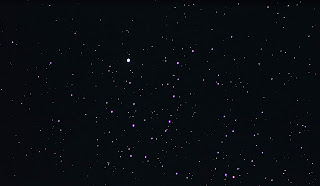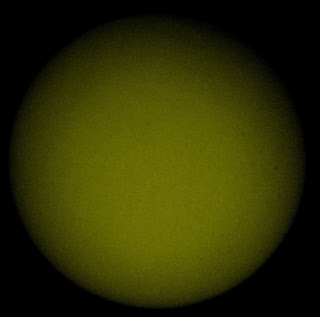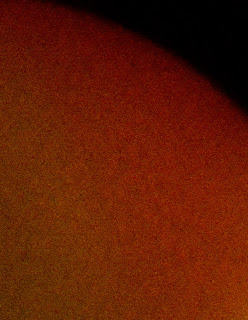October 27th 2140 GMT Deep Sky Shoot
Conditions were not perfect but clear enough for objects
well clear of the horizon to leave some light on my camera. I also kept more
than half an eye out for meteors. As well as the fading Orionid shower, there
were many minor showers around that I thought might produce the odd meteor. I
did not see any, though.
I had another go at the Pleaides (M45) but went for a closer
view at 300mm focal length, ISO 6400 and 2 seconds exposure. I stacked 99 frames but did niot catch any nebulosity.
I could not get Melotte 20 into my field of view, so
switched targets to M35 instead.
No, didn't get it either!
I returned to Melotte 20 with 70mm focal length and 8
seconds exposure. I only took seven frames but was very happy with the outcome.
October 23rd 2330 GMT Deep Sky: Hyades and Pleiades
I took a few shots of the Hyades and Pleaides at 70mm focal
length, ISO 6400 and 6 seconds exposure.
October 22nd 2020 GMT
I fiddled with the intervalometer and had another go at the
Perseus region. I hoped to catch some activity from the two minor Taurid
showers, with an outside shot at some Orionids travelling vertically from below
the horizon.
Unfortunately, I only caught cloud and some fuzzy images!
October 20th 0000 GMT Moon and Meteor
By the time I had copied the files from my camera, the Moon
was well clear of the horizon. I took some full disc lunar shots with my Mak
and DSLR at 1.54m focal length, ISO 100 and 1/250 second exposure. I stacked 122 images to get this.
I then took some sets of close-ups by adding a 3x Barlow,
with 1.62m focal length, ISO 100 and 1/25 second exposure. I stitched 8 different imaging runs but combined the results to end up with 3 images.
October 19th 2015 GMT Meteors and Constellations
The sky was clear-ish, so I set my first meteor trap of the
month. I aimed at Perseus with my DSLR at ISO 6400, 16mm focal length and 6
seconds exposure. I set my camera to automatic with my intervalometer.
At 2130 GMT I moved the camera to the general area of
northern Taurus, hoping for a possible increase in meteor numbers.
Unfortunately, neither imaging run revealed any meteors and not enough detail of the constellations.
October 19th 1800 GMT Jupiter
It was dusk and Jupiter was low. I took some exposures with
my DSLR at 300mm focal length, ISO 6400 and 1 second exposure in an attempt to
capture the moons.Although focus was slightly off, the moons showed well.
October 19th 1430 GMT Sun
I had a rare bit of clear sky, so did a hydrogen alpha shoot
with my PST and DSLR. This time, I used a lens hood.
Oct 19th 0705 GMT Moon
October 18th 2130 GMT Moon
It was mostly cloudy in the evening but a hole opened up in
the cloud that allowed me to perform a lunar shoot. I used 300mm focal length,
ISO100 and 1/1000 second focal length. I tried a different processing sequence and produced a better result.
October 16th 0900 GMT Sun
The Big Bear solar images had been showing a quiet sun for a few days but it was almost criminal not to have a go at it. As sunspots had been absent for some time, I used a Coronado PST and DSLR afocally to take a few images. There was some detail in the close-ups but I would have had better results if I had remembered to use my lens hood.
October 15th 1935 GMT Moon
Conditions were better than they were 2 days previously but the Moon was low and shrouded in thin cloud. With more cloud spreading from the west, I decided to do a quick shoot with my DSLR in case there were no more opportunities that evening. I used 300mm focal length, ISO 100 and 1/1000 second exposure.
October 13th 2100 GMT Moon
Conditions were poor but it had seemed so long since I had
seen anything at all, I just had to shoot the Moon. I used 300mm focal length,
ISO 100 and 1/1000 second exposure.
October 9th 2110 GMT
October 8th 2000 GMT Moon
The Moon was just past first quarter but low down. I took
some shots at 300mm focal length, ISO100 and 1/1000 second exposure.
October 2nd 1815 GMT Moon
The crescent moon was low and I snapped it with my DSLR at
300mm focal length, ISO 100 and 1/500 second exposure. Unfortunately, it was under-exposed and the focus was poor.
October 2nd 0900 GMT Sun
The Big Bear images showed some minor solar activity in
hydrogen alpha light and none in white light. I could not see anything in my
Coronado PST but hoped I might capture something “on film”.






























